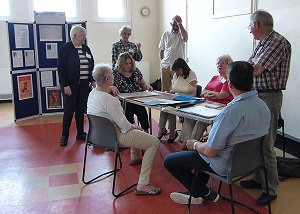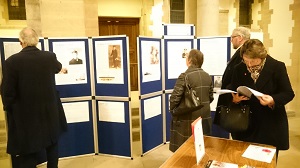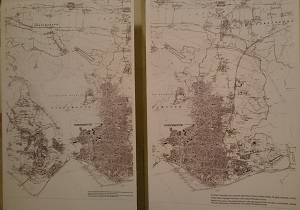Project Summary
This map is the result of a collaboration between the Portsdown U3A and the University of Portsmouth’s Port Towns and Urban Cultures (PTUC) group, and was generously funded by the Heritage Lottery Fund. Portsdown U3A and PTUC would like to thank the University of Portsmouth’s Research Assistant, John Bolt, for his work on the project, and the University’s Online Course Developers, Daren Cooper and Scott Simmonds, for their assistance in creating the map.
The History of the Portsdown Project
In September 2013, at one of the meetings of Portsdown U3A Local History Group, members were discussing the forthcoming centenary of the start of World War One. They felt that the group should consider researching some local aspect of the conflict. Even before the centenary, the emerging media coverage was, understandably, concentrating on the carnage of the Western Front, to the exclusion of all other theatres of the war, and other branches of the armed forces. One of the Portsdown U3A’s number, Ted Harfield, said that his grandfather had served, as a marine, on HMS Iron Duke at the Battle of Jutland, and, every year, at the anniversary of the battle, he would become very withdrawn and quiet. Ted had also recently read a blog by local historian James Daly equating the scale of the loss of men from Portsmouth and Gosport, at Jutland, with that of a ’Pals’ battalion at the Battle of the Somme: residents in virtually every street in Portsmouth and Gosport had someone who was lost or a close relative killed. Testing the veracity of these ‘beliefs’ became the starting point for this project; with the initial aims being to assemble a list of all those sailors and marines from the two towns who lost their lives at Jutland, and to plot the local address of their next of kin at the time of the battle on a paper copy of a contemporary street map. At the beginning, it was merely envisaged that whatever was produced would be exhibited at one of Portsdown U3A’s ’Open Afternoons’. Little did we realise that this ’simple’ idea would metamorphose into a far greater undertaking.

By October 2013, Ted had found the acknowledged comprehensive list of all those British servicemen lost at Jutland, originally researched by retired New York detective Don Kindell. The casualty list was gradually divided up between those Portsdown U3A Group members who volunteered to become involved. To assess whether each individual casualty had a connection with Portsmouth or Gosport, each serviceman’s place of birth, and address of next of kin in May 1916, was researched. For ‘rank and file’ members of the Royal Navy and Royal Marines, this information could be found on the UK Royal Navy and Royal Marine War Graves Roll, 1914 - 1919. For commissioned officers, however, information was more difficult to ascertain. Some could be gleaned directly from the Commonwealth War Graves Commission Roll, which, in other cases, provided leads to the information sought via the details of wives, parents, and ages. In addition, for each man, the 1911 census was checked for residential address, and place of birth of any wife and children. Given that the British Fleet suffered 6097 fatalities, this was no mean undertaking, and took a considerable time; though, by December 2013, some members of Portsdown U3A Genealogy Group had become involved. Moreover, research into the next of kin of those men lost quickly drew everyone into a wider inquiry into the post-Jutland fate of at least some of the men’s nearest and dearest. By late 2014, this inquiry had become an integral second phase of the project.
In any case, the project had already developed significantly as Portsdown U3A had considered the possibility of sharing the outcome of their research with, at the very least, those whose forebears were casualties at Jutland. The Group first contacted Portsmouth Museum in late 2013, with a view to the inclusion of the map in any exhibition they might be holding in 2016. Interest was expressed, and, in the interim, the Group were asked to produce some potted biographies of Portsmouth-based ships, for which the Museum held artefacts, for their Lest We Forget exhibition, a commemoration of the outbreak of war in 1914.
Although the Museum did not go on to hold an exhibition in 2016, it was through them that Portsdown U3A made contact with the National Museum of The Royal Navy (NMRN), in Portsmouth Dockyard. Members of the Group had a meeting with them in July 2014; again with a view to gaining exposure for the map. However, at that time, the NMRN were not even considering any exhibition to mark the Jutland Centenary. It was to be another 12 months before our paths crossed again.
Of more immediate import at that time was the initial contact, through Lest We Forget, that Portsdown U3A made with the University of Portsmouth’s History Department; and the assistance and encouragement the Group received from that quarter. It was on the issues of the map and the financing of the project that the discussions, which began in September 2014, had most impact.
The greatest change in the Group’s plans was generated by the University’s interest in the production of the map electronically and the hosting of it on the Port Towns and Urban Cultures website. This would mean that Portsdown U3A’s findings would be accessible to a worldwide audience and that hard copies of the map could be produced with ease. This, in turn, made viable the prospect of local exhibitions. Moreover, the costs associated with the production of the map and the requirements for display of the findings clearly necessitated some funding. This would also allow the Group to preserve the Jutland heritage for the local community. The partnership that grew from this development, thanks in great part to Professor Brad Beaven, Dr Melanie Bassett, and Dr Rob James, added further support and collaborative research from the University of Portsmouth. In particular, Dr Bassett’s own research provided further input to our data on the Portsmouth Jutland casualties, which proved an added benefit to our comprehensive study. So it was that, in July 2015, Portsdown U3A applied for a grant from the Heritage Lottery Fund and secured it in September of that year.
In the meantime, the expansion of the project to encompass some research into the fate of the bereaved families post-Jutland required some selectivity. The Group were aware that, even in partnership with members of the Genealogy Group, it would not be able to look at all the families, and opted to concentrate on a cross section of those with children, who would probably be hardest hit financially. To this end, a list of questions was drawn up to try and investigate the financial standing of the family at the time of Jutland; if the family had relatives in the area who might offer support; whether the widow made any changes to their circumstances post-Jutland; and whether they had been forced by circumstance to approach any of the various contemporary agencies for assistance.
This aspect of the Group’s research was hampered by the 100 year rule, meaning that it had, for example, no access to the 1921 Census. While there is a Commonwealth War Graves Commission list of sailors and marines lost, published in 1924, that sometimes gives some information on next of kin, such as their then current address and marital status, it is by no means to the same standard of detail for every entry. Consequently, the Group decided to try to talk to families whose ancestors had served at Jutland. The advantages would be twofold, in that not only would insight into how families coped would be gained, but also possibly the Group would be able to gain some idea of the character of the sailors and marines themselves; and perhaps a photograph or two, to be able to put a face to a name.
Firstly, early in 2015, the Group made an appeal in the national U3A magazine. From this it received some responses volunteering information and photographs, and others asking for information; which it was only too happy to supply, when it was able. The Group also hoped that a U3A in Plymouth or Chatham might take up the idea, and produce a comparative study; but unfortunately this has not happened yet. In addition to the appeal in the U3A magazine, Ted Harfield had written to Portsmouth’s local paper, The News, requesting information. Several people responded and were interviewed by Ted. The Group’s main strategy for contacting relatives, however, was a series of ’open sessions’ at various venues around Portsmouth and Gosport, to which people were invited to come and talk about their Jutland relatives. ‘Invitations’ were by way of articles in The News and the distribution of leaflets. The ‘drop-in’ sessions commenced in early 2016 and were accompanied by an interim exhibition showcasing some of the initial results of the research.

From the end of 2015, interest in Jutland was also developing in a variety of ways. At the University of Portsmouth, plans were made to explore the national impact of the battle and to seek funding for this further research from the Gateways to the First World War Engagement Centre, of which the University is a constituent part. At the same time, the NMRN re-established contact and became a partner in this enterprise. It was their intention to stage a large Jutland exhibition in Portsmouth Dockyard, one feature of which was to be an interactive map showing where all the 6097 British sailors and marines lost were born, and other information on each man; with the public invited to add to this body of knowledge. The information on the initial 2000 plus men featured on the map was that which was provided by Portsdown U3A’s original project. The information that the U3A and UoP provided has also been used in the NMRN’s Jutland exhibition and interactive map and at the Greenwich Maritime Museum Jutland exhibition, as Greenwich asked the NMRN for permission to share their map.
These developments meant new opportunities for showcasing Portsdown U3A’s own project. The Group was given its own webpage on the Gateways website. In addition, it had made contact with Ken Roberts’ ’20 Streets’ project, based at St. Wilfrid’s Church, Buckland. They were undertaking not dissimilar research on all those men featured on the Church’s Roll of Honour, from all three services. Where there was an overlap, Portsdown U3A was happy to provide what information it had on those Jutland casualties who were resident in the 20 streets surrounding the Church.

As the actual centenary of Jutland approached, there were further developments. Of particular importance to Portsdown U3A’s research into the families of casualties was its contact with Commander (now Captain) Andy Green, RN, who was organising the Portsmouth Jutland Memorial Service that was to be held at Southsea Naval War Memorial on May 31st. Through Andy Green’s good offices, the Group was able not only to write a short speech, for the Lord Mayor to deliver at the service, on the impact of the Battle on both the town and people of Portsmouth, but also to honour these men, that it had somehow become close to through its research, by being allowed to lay a wreath at the service. Andy was also kind enough to share with the Group emails he had received from family members who wished to attend the service. Through these, the Group was able to contact those with a Portsmouth or Gosport connection.
By the summer of 2016, a hard copy map of the Battle of Jutland Portsmouth casualties was produced by PTUC’s Research Assistant John Bolt, ready for use in Portsdown U3A’s various pop-up exhibitions. This included an exhibition of the Jutland map and the Group’s research on the occasion of the centenary of the Battle of Somme, which included two special screenings of the silent film The Battle of Somme (1916) at Portsmouth Anglican Cathedral in Old Portsmouth. Students of Portsmouth High School and members of the public were able to see the film and examine the Jutland map and research.
In June 2016, members of Portsdown U3A were invited by Professor Brad Beaven and Dr Melanie Bassett of the University of Portsmouth to join them in a seminar entitled More Than Just Jutland that was hosted at the University of Southampton.
In the latter stages of the project, Portsdown U3A's Jutland Research Group will continue to showcase its findings in a series of pop-up exhibitions for the local community, and in an article exploring the impact of the battle on the bereaved families.
Carole Chapman and Steve Doe, Portsdown U3A Jutland Research Group.
John Bolt and Rob James, Port Towns and Urban Cultures.



